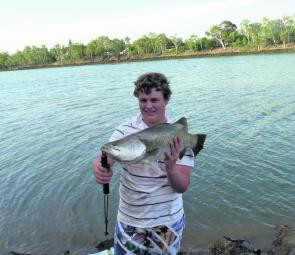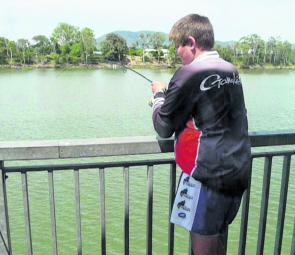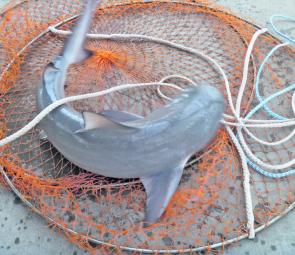Have you ever been to a new fishing spot only to be put off by the countless anglers already there showing the tell-tale signs they haven’t caught a thing? A lot of fishers can easily identify a good fish holding structure but they just don’t know how to fish it properly. These areas require a little more technique than just tossing out a prawn and hoping for the best.
Structures can be pontoons, bridges, wharfs and even rock walls. All of which can be successfully fished with the correct guidance and preparation.
The most common error anglers make is to head on down to their local tackle shop and pick up a bag of prawns for bait before considering where they’re going or what they’re targeting. Prawns are fantastic bait, but only when used in the proper area and for the right quarry. Using the correct bait is essential for success, otherwise the chances of hooking up on a lovely fish is zilch.
The best way to gauge the most suitable bait is to grab a cast net and see what is swimming in the area. Generally, whatever baitfish you catch in abundance is what will work best. In my local area, bony bream and poddy mullet are the most commonly netted baitfish. If you do not own a cast net, chat with your local tackle store who will be able to hook you up with a bait that works.
Rigs are the next stumbling block anglers face. The local pontoons are riddled with sharks and large barramundi, so the normal 6lb standard line on the small weekender combos may not work too great. Your rigs will ultimately depend on the predator species around the structure.
Due to the number of sharks and barra in my locality, the rigs I use are tailored to that situation; 20lb line to 1m of 60lb leader that will help with gill breakers and shark tails, all the way up to a 20lb nylon-coated 20cm wire strand that will stop the sharks teeth but won’t shy away the barra.
To top it all off, I use a 3/0 to 6/0 hook depending on the size of the fish and bait on that particular day.
Once the bait and rigs are sorted, you now have to put the bait on the hook. Don’t just throw the hook anywhere, the effort you put in will be paid off when that fish of a lifetime swims past and hammers down that perfectly presented bait.
The common place to hook live bait is under the dorsal fin or just before the tail, although hooking through the top and bottom jaw can also work well. The most important point when putting a hook through a livie, or any baitfish, is to leave the barb and the majority of the hook protruding from the bait. Follow this up by examining the bait after a fish has taken a shot at it; are the majority of the bites on the tail, back, head, or underneath? Change where you put the hook to suit the pattern – it’s all about being aware.
Matching the appropriate gear for the fishing spot is also crucial. You wouldn’t fish an overhead combo for a flathead, so why fish for sharks and barra with incorrect gear? Don’t blame your tools if you didn’t bother to get the right one in the first place.
Most people around Central Queensland would have a typical barra bait cast combo with 20lb mono or braid. This can easily be adapted by leaving it in free spool, or with the drag turned right off, so when the fish hit and run they don’t feel any line and won’t drop the bait. Once the fish has taken a few metres of line, tighten the drag or engage the reel and watch the slack line disappear and the rod load up.
So you’re up 10m above the water on a pontoon and have hooked a big shark or barra, how the heck do you get it up to where you are? A simple method is a crab pot with no top, this can be lowered down to swim the fish into and hoist it up onto the pontoon. If you’re off a jetty or rock wall, a landing net or pair of good lip grips are all that is needed.
Most fish, like barramundi and salmon, require a lip grip in the mouth and a hand under the belly for adequate handling, but sharks are a different story. If you aren’t game enough or don’t want to risk it, just cut the hook off and get it back in the water. For those of us who like the adrenaline rush, one hand firmly gripped around the tail and another pinching tightly above the gills is the correct method for holding these fierce creatures, but hold on tight as they are very powerful.
When hooking and retrieving sharks, take note on how they take the bait. They will hit and run, rather than play around with it in their mouth like barra. The more you get to know how each species takes the bait, the better equipped angler you become. You will begin to recognise and identify the different fish species, start knowing and feeling when the right time to hook, and you will know how they fight.
Many areas around Rockhampton can be fished in this manner. For example, the old wharf down along Quay Street, the new boat ramp jetty near the boat club and the land outside Moores Creek near the Bowls Club. All of these places can be fished properly and with ease, it just takes preparation.
If you are looking for a more family-friendly alternative, the sheltered wooden deck along the Quay Street walkway is a great spot. There are seats, freshwater, lots of grass for activities if the kids get bored, nothing dangerous around and it’s in the middle of the city.
Another alternative is the three pontoons, or ‘towers’ as my mate calls them, just over the road from the new playground, tennis courts and basketball stadium on Huish Drive. Once again, this spot offers a place for the kids, but it has railings that cover the perimeter, table and chairs, more seating, lights, power points and a barbeque.
Reads: 2566
A beautiful 75cm+ barra caught while targeting the local structures.

The safest way to hold a shark is to hold its tail firmly with one hand and firmly grip above its gills with the other.

Jack Arndt hooked up to a shark using a bait runner.

A crab pot with no top is a safe and easy way of getting your hooked shark from the water to the top of a 10m high pontoon.




